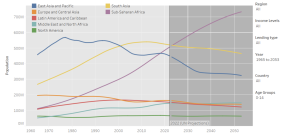International Day of the African Child: Empowering our leaders of tomorrow
“The youth of today are the leaders of tomorrow.” Spoken by Nelson Mandela, these words ring true, eluding time and geopolitical context. For Africa, they resonate today more than ever before – because of our historic boom in the population of young people.

Graph and data
World Bank data showing population growth of young people (0-14) throughout the world
Investing in education is investing in the future, and with Sub-Saharan Africa certainly not lacking potential with its rapidly growing population of young people, prioritizing fruitful education systems is essential. Unfortunately this can be difficult, and as always barriers get in the way.
It is these education challenges that contribute to Learning Poverty – defined as the percentage of 10-year-olds unable to read a simple sentence – in Sub-Saharan Africa the rate of Learning Poverty is 90%.
The UN’s Sustainable Development Goals (SDGs) are at about the halfway point, the fourth goal, aiming to “ensure inclusive and equitable quality education and promote lifelong learning opportunities for all,” is clearly being missed in many Sub-Saharan African countries, despite considerable investment – highlighting the need for solutions that deliver outcomes.
On the continent there are some leading examples of education programs that go against the trend and transform learning outcomes. The [Bridge Liberia, RwandaEQUIP, EKOEXCEL, EdoBEST, BayelsaPRIME] programs are delivering a vision and way forward for pupils to learn in a meaningful way.
Supported by NewGlobe as a technical partner, the program is successfully building holistic education systems through data-driven pedagogy, innovative learning technologies, and powerful school administration systems.
In 5-10 years Africa will provide about half of the world’s increase in the working-age population – investing in future generations’ learning will determine the skill set of these world shaping young people.
With the population of Sub-Saharan Africa skyrocketing, so does the demand for essential services like healthcare, infrastructure, and all the elements that create and maintain a prosperous society. Education is the foundation of these services, and will provide a pathway for Africa’s young people to seize career opportunities.
On an economic level, the potential of embracing Africa’s youth population increase through education is clear.
The World Bank estimates that one extra year of education correlates with 10% higher household income, and one extra year on average for a country translates overall to 2.5% higher GDP per capita.
Additionally, a study co-authored by the Yidan Prize winner Professor Eric Hanushek estimates the value of ensuring all students achieve global basic-level skills. In Sub-Saharan Africa 94% of youth do not reach basic skill levels, heavily contributing to global levels, which have been estimated at present value to equate to a lost world economic output of more than $700 trillion over the remaining century – highlighting the alarming opportunity cost of not investing in African human capital. Civil societal and social cohesion also heavily rest on education.
When a young person lacks confidence in their education system and is unable to embrace learning, they are put at risk. Young people with poor education outcomes tend to have less economic prospects, locking them in a vulnerable position, and increasing their risk of becoming victims of vice, such as human trafficking – something many African governments battle with.
With more and more pupils to educate, it is incumbent on leaders and education stakeholders to strengthen the bedrock that is learning.
Approximately 27,000 people are born every day in Sub-Saharan Africa, and every new young person’s learning will be reliant on an education system’s ability to adapt. Considering this huge influx of new students into education systems every year, passive solutions will not cut it – governments need bold education transformation at speed and scale.
The World Bank highlights that many current education systems are at capacity, and the demand will increase with nearly 750 million African children expected to be of school age by 2060.
The Liberian Government’s, Liberia Education Advancement Program (LEAP) is meeting this challenge.
The program, launched in 2016,is a multi-partnership educational model that delivers 100% tuition free primary education throughout Liberia from Early Childhood through grade 9.
Bridge Liberia is the largest technical partner in the LEAP Program. Currently, Bridge Liberia supports over 300 public primary schools, where 75,000 students are enrolled with over 1,500 trained teachers by Bridge Liberia and the Liberia Government.
Liberia’s House of Representative Chair on education, Hon. Mariamu Fofana stated in an interview how the impact of the program has grown, providing opportunities for girls to match boys in schools
“I am very pleased based on my own interaction with Bridge Liberia and the schools they are managing in Liberia. Their model of teaching is really helping our children. The fact that the approach puts girls on the same path with boys makes me happy. Indeed when you give a girl equal opportunity as the boy, she would learn equally, if not more. And I am highly pleased that there is research that shows that indeed this system that is used in other countries is the same used at our schools supported by Bridge.”
Africa’s greatest asset is its young people. Their potential is exciting and unprecedented, and this International Day of the African Child we must empower potential by finally providing an education that achieves learning. Then the children of Africa will be able to deliver success not just for themselves, not just for Africa, but for the whole world.

